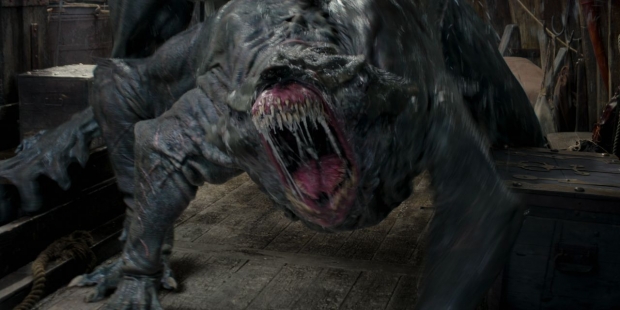The award-winning visual effects studio creates the huge-jawed Aeschna sea monster, the deadly Flesh Monster, and a huge Ring of Fire, in the hit fantasy adventure’s latest season; watch the final S3 episodes now on Netflix.
Having been part of the BAFTA award-winning VFX team for Netflix’s The Witcher Season 2, Cinesite was once again tapped to help create the epic battles and fantastic creatures featured in Season 3 of the hit fantasy adventure. The studio was entrusted with some of the series’ most ambitious VFX to date, overseen by VFX Supervisor Tim Crosbie and VFX Producers Angie Wills and David Stephens.
Cinesite’s previous delivery of the Kikimora, the first monster seen in Season 1’s opening shots, and Season 2’s Basilisks and Chernobog set it up to “tackle the complex, multi-limbed Flesh Monster, as well as the crocodile-like Aeschna in Episode 4 [Season 3],” explained Cinesite VFX Supervisor Richard Reed, adding, “It was truly exciting and fulfilling to bring these creatures to life.”
Cinesite’s team was closely involved in look development of the Flesh Monster, a fusion of the torsos and limbs of women, that moves like a crab in the dark while attacking simultaneously with its multiple arms. Geralt first encounters the Monster in the dungeons of Vuilpanne Castle. The creature’s movement is seamlessly integrated into the subsequent fight captured with three stunt performers fighting side by side.
“We started with the initial brief of a creature composed of multiple human bodies fused into one and developed a series of ZBrush concepts,” shared Cinesite Head of Assets and Visual Development Maddie Scott-Spencer, who was integral to the process of conceiving the look of the Flesh Monster and its movement throughout the sequence.
Challenged to create this multiple-limbed surrealist creature whose motion could be see clearly in the dark, the team explored novel ways to create striking silhouettes.
“With such a complex creature shape in motion,” Scott-Spencer continued, “we aimed for a design that would read as both horrifying and elegant in its proportions and form. As part of the design journey, we incorporated a two-stage posture where the Flesh Monster rears up into an upright pose revealing a towering, threatening display of arms, legs, and disturbing negative space. It was a great challenge which we addressed across multiple concept rounds, refining the design into the final sculpting and modeling phase.”
In Season 3, Episode 4, the Aeschna suddenly jumps from the water onto the deck of the chain ferry, creating a new set of challenges for the Cinesite team.
“Animating a large creature within the confined space of the chain ferry deck was a challenge our team rose to meet with careful choreography and clever animation,” added Scott-Spencer. “They created whole and tail-less versions of the monstrous amphibian, as well as its dismembered tail, which is ripped off by the ship’s gear mechanism. Details like sea-water drips, blood, and drool were also added to enhance the creature’s terrifying impact.”
Another impactful VFX creation the team contributed to was the Ring of Fire, an entirely CG structure that hovers above the courtyard at Aretuza. Towards the end of the season, destroyed, it is “dripping like liquid napalm as it disintegrates and falls.” The destruction around Aretuza’s battle also includes a 30-second longshot through an interior courtyard, among other interior battle shots.
“Cinesite was tasked with enhancing and developing Aretuza from previous seasons so that we get to see some new hero views and, ultimately, the destruction of a good portion of it,” shared Reed. “I’m incredibly proud of the whole team’s work; everyone stepped up to the challenge.”
The final episodes of The Witcher Season 3 are now streaming on Netflix.
Source: Cinesite

















